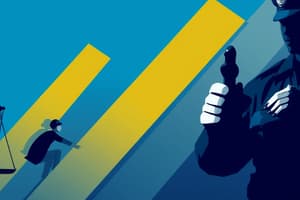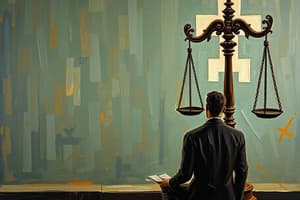Podcast
Questions and Answers
What is the primary distinction between felonies and misdemeanors?
What is the primary distinction between felonies and misdemeanors?
- Felonies involve violence, while misdemeanors do not.
- Felonies are committed with intent, while misdemeanors are not.
- Felonies can only be tried in federal court.
- Felonies result in longer imprisonment than misdemeanors. (correct)
Which of the following best defines 'Actus Reus'?
Which of the following best defines 'Actus Reus'?
- The legal justification for committing a crime.
- The punishment prescribed for a crime.
- The physical act of committing a crime. (correct)
- The mental state behind the crime.
What is the purpose of rehabilitation programs in corrections?
What is the purpose of rehabilitation programs in corrections?
- To punish offenders without aim for reintegration.
- To ensure offenders are incarcerated for longer periods.
- To encourage offenders to commit more crimes.
- To provide educational and therapeutic assistance. (correct)
Which policing strategy emphasizes building community relationships?
Which policing strategy emphasizes building community relationships?
What role do federal agencies like the FBI fulfill?
What role do federal agencies like the FBI fulfill?
Which defense claims a lack of mental capacity to understand the crime?
Which defense claims a lack of mental capacity to understand the crime?
What does the term 'parole' mean in the context of corrections?
What does the term 'parole' mean in the context of corrections?
Which of the following is NOT a characteristic of a misdemeanor?
Which of the following is NOT a characteristic of a misdemeanor?
Which correctional system is primarily for short-term detention?
Which correctional system is primarily for short-term detention?
Juvenile courts are distinct from adult courts primarily in their emphasis on what?
Juvenile courts are distinct from adult courts primarily in their emphasis on what?
What distinguishes felonies from misdemeanors in terms of punishment?
What distinguishes felonies from misdemeanors in terms of punishment?
Which principle ensures that a person cannot be tried for the same crime more than once?
Which principle ensures that a person cannot be tried for the same crime more than once?
Which correctional approach emphasizes the importance of rehabilitation over punishment?
Which correctional approach emphasizes the importance of rehabilitation over punishment?
What is a primary function of local police agencies?
What is a primary function of local police agencies?
What defines an infraction in the context of criminal law?
What defines an infraction in the context of criminal law?
How is parole different from probation?
How is parole different from probation?
Which of the following accurately describes the role of rehabilitation in the corrections system?
Which of the following accurately describes the role of rehabilitation in the corrections system?
In what type of court are cases initially heard and decided?
In what type of court are cases initially heard and decided?
What is the primary focus of community policing?
What is the primary focus of community policing?
Which component of corrections is primarily designed for the long-term confinement of serious offenders?
Which component of corrections is primarily designed for the long-term confinement of serious offenders?
Flashcards are hidden until you start studying
Study Notes
Criminal Law
- Definition: Body of law that defines criminal offenses and prescribes punishments.
- Categories:
- Felonies: Serious crimes (e.g., murder, robbery) usually punishable by imprisonment for over a year or death.
- Misdemeanors: Less serious offenses (e.g., petty theft) typically punishable by fines or imprisonment for less than a year.
- Elements of Crime:
- Actus Reus: The physical act of committing a crime.
- Mens Rea: The mental state or intent behind the act.
- Defenses:
- Insanity: Claiming a lack of mental capacity to understand the crime.
- Self-defense: Justification for committing an act to protect oneself.
Corrections
- Purpose: To rehabilitate offenders, deter crime, and provide public safety.
- Systems:
- Prisons: Secure facilities for long-term confinement of serious offenders.
- Jails: Local facilities for short-term detention before trial or for minor offenses.
- Probation: Court-ordered supervision in the community instead of incarceration.
- Parole: Early release from prison under supervision, contingent on good behavior.
- Rehabilitation Programs: Educational, vocational, and therapeutic programs aimed at reducing recidivism.
Law Enforcement
- Role: To enforce laws, prevent crime, and maintain public order.
- Agencies:
- Local Police: Handle everyday crime and community issues.
- State Police: Oversee highways and state law enforcement.
- Federal Agencies: Handle specific areas (e.g., FBI for federal crimes, DEA for drug enforcement).
- Policing Strategies:
- Community Policing: Building relationships between police and communities to prevent crime.
- Problem-Oriented Policing: Identifying specific problems and developing tailored responses.
Theories Of Crime
- Biological Theories: Suggest that genetics and physiology can predispose individuals to criminal behavior.
- Psychological Theories: Focus on individual mental processes and personality traits that contribute to criminality.
- Sociological Theories:
- Strain Theory: Crime results from the pressure to achieve societal goals without the means to do so.
- Social Learning Theory: Crime is learned behavior through interaction with others.
- Control Theory: Lack of social bonds leads to higher likelihood of criminal behavior.
Juvenile Justice
- Definition: Legal system addressing offenses committed by minors (typically under 18).
- Key Features:
- Separate System: Juvenile courts and detention facilities aimed at rehabilitation rather than punishment.
- Diversion Programs: Alternatives to formal prosecution to keep juveniles out of the system.
- Factors Influencing Juvenile Crime:
- Family Environment: Influence of family dynamics and socioeconomic status.
- Peer Pressure: Impact of associations with delinquent peers.
- Mental Health: Role of psychological issues in juvenile offending.
Criminal Law
- Body of law defining criminal offenses and establishing punishments.
- Felonies: Serious crimes, such as murder and robbery, often punishable by more than a year in prison or death.
- Misdemeanors: Less severe offenses, like petty theft, generally punishable by fines or less than a year of imprisonment.
- Elements of Crime:
- Actus Reus: The actual physical act of committing a crime.
- Mens Rea: The intent or mental state behind the act.
- Defenses include:
- Insanity: Argument asserting the offender’s inability to comprehend the crime due to mental incapacity.
- Self-defense: Justification for an action taken to protect oneself from harm.
Corrections
- Aims to rehabilitate offenders, deter future crime, and ensure public safety.
- Systems comprising:
- Prisons: Facilities for long-term confinement of serious offenders.
- Jails: Local institutions for short-term detention pre-trial or for minor offenses.
- Probation: Supervised community-based penalty instead of incarceration.
- Parole: Conditional early release from prison, requiring good behavior.
- Rehabilitation Programs include educational, vocational, and therapeutic initiatives designed to lower rates of reoffending.
Law Enforcement
- Responsibilities involve enforcing laws, crime prevention, and maintaining public order.
- Agencies include:
- Local Police: Manage everyday crime and community matters.
- State Police: Responsible for highway safety and state law enforcement.
- Federal Agencies: Target specific issues, such as the FBI handling federal crimes and the DEA addressing drug-related offenses.
- Policing Strategies encompass:
- Community Policing: Enhancing relationships between police and community members for effective crime prevention.
- Problem-Oriented Policing: Identifying crime-related problems and crafting specific solutions.
Theories of Crime
- Biological Theories: Propose that genetic and physiological factors can make individuals more prone to crime.
- Psychological Theories: Examine mental processes and personality features that might contribute to criminal actions.
- Sociological Theories:
- Strain Theory: Suggests that crime occurs when individuals are pressured to achieve societal objectives without adequate means.
- Social Learning Theory: Views crime as a behavior acquired through interactions with others.
- Control Theory: Posits that weak social bonds increase the likelihood of criminal behavior.
Juvenile Justice
- Legal framework targeting offenses by minors, typically those under 18 years old.
- Key Features:
- Operates a distinct system with specialized juvenile courts and detention centers focusing on rehabilitation rather than punishment.
- Diversion Programs: Alternatives to formal prosecution, aiming to prevent minors from entering the justice system.
- Factors Influencing Juvenile Crime include:
- Family Environment: The effect of family dynamics and socioeconomic conditions.
- Peer Pressure: Influence and impact of associations with juvenile delinquents.
- Mental Health: The role of psychological disorders contributing to juvenile offending.
Criminal Law
- Defines criminal offenses and their punishments.
- Felonies: Serious crimes, such as murder and rape, punishable by imprisonment over one year.
- Misdemeanors: Less severe offenses like petty theft and vandalism, usually resulting in fines or imprisonment for less than one year.
- Infractions: Minor violations, such as traffic offenses, typically incur fines rather than imprisonment.
- Presumption of Innocence: Accused individuals are considered innocent until proven guilty, ensuring fairness in legal proceedings.
- Double Jeopardy: Prohibits trying a person for the same crime more than once to protect against ongoing legal harassment.
- Due Process: The requirement that all legal rights must be afforded to an individual by the state, ensuring justice and procedural fairness.
Corrections
- Aims to rehabilitate offenders while providing punishment and ensuring public safety.
- Prisons: Designed for long-term incarceration of serious offenders (felons).
- Jails: Used for short-term confinement of individuals awaiting trial or serving brief sentences.
- Probation: Allows individuals to serve their sentences in the community under supervision and specified conditions.
- Parole: Early release from prison that comes with conditions to follow post-incarceration.
- Ongoing debate exists between focusing on rehabilitation versus punishment within correctional systems.
Law Enforcement
- Responsible for enforcing laws, maintaining public order, and investigating crimes.
- Local Police: Focus on community policing and responding to local criminal activities.
- State Police: Handle law enforcement and investigations at the state level.
- Federal Agencies: Include the FBI, DEA, and ATF, dealing with specific crimes that cross state lines.
- Community Policing: Builds partnerships and relationships with community members to enhance trust and cooperation.
- Crime Prevention: Involves strategies aimed at stopping crime before it happens, enhancing community safety.
Court System
- Composed of various levels of courts managing legal cases.
- Trial Courts: Where cases start and are initially judged.
- Appellate Courts: Review trial court decisions for potential legal mistakes.
- Supreme Courts: The highest legal authority that interprets laws and adjudicates significant legal issues.
- Arraignment: The first court appearance where the accused is formally charged.
- Plea Bargaining: An agreement between prosecution and defense to resolve cases with reduced charges or sentences.
- Trial: The process of evaluating evidence to determine the guilt or innocence of the accused.
- Rights of the Accused: Include the right to a fair trial, legal representation, and the right to remain silent, ensuring legal protections for individuals.
Studying That Suits You
Use AI to generate personalized quizzes and flashcards to suit your learning preferences.




